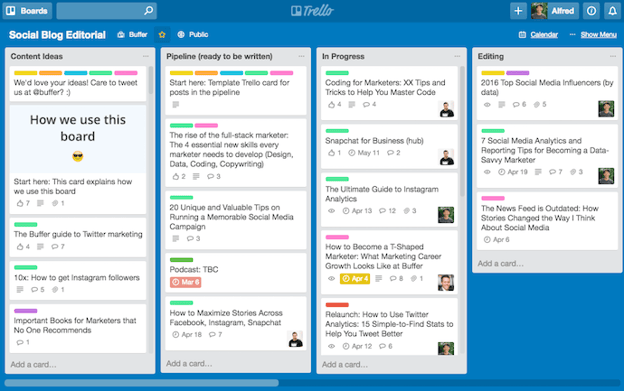4 Tips for Improving Your Social Media Performance
Social media is a cornerstone of digital marketing. In the U.S. alone, there are an estimated 308 million people on social media in 2023. That number is expected to continue to grow, reaching 331 million by 2028. When you consider that the entire U.S. population is 334.5 million people, you can see what a massive portion of the population is on social media. A brand looking to reach its target audience has a huge opportunity by leveraging this tactic.
Here are some quick tips for improving your social media performance:
- Select the right platform and medium
- Establish clear content goals and make sure your call to action (CTA) matches
- Lock in your content theme and develop your own unique voice
- Track performance with built-in tools
These four tips can help your brand boost performance. Want to learn a bit more? Keep reading to explore each of these best practices.

1. Select the right platform and medium
This is a vital first step. It won’t matter how compelling your content is, the reality is, if your target audience is not on the social media platform(s) you choose, your message will not be seen. Make sure you’re reaching your target audience by completing the necessary research into each platform. This also means you need to know your audience well. Consider basic demographics such as age, gender, location and income to start.
Take a deeper dive and learn what makes your target audience tick. Since each social media platform offers a different user experience, it can be helpful to know which style attracts your target. Are they inspired by photography? Then, Instagram could be a good fit. Is your target Gen Z and engaged by short-form video? Then, you’ll likely want to be on TikTok. Perhaps you have a Gen X or Millennial target and they’re most interested in staying in touch with friends and family. In that case you might see the best performance on Facebook.
Once you understand your target, consider developing personas to help guide your platform choice. A persona is a sample customer, and not only does it include standard demographics, but it can also include details such as familial status, hopes, wants, a snapshot of daily life, how they prefer to communicate and other pertinent descriptors.
From this point, investigate your platform options. Start with basic demographic information provided by the social media platforms. Then, review each one and determine which medium (text, photo, video, etc.) will best match your target personas.
Narrow your choices down to one platform, or no more than three. You don’t want to spread yourself (and your budget) too thin by trying to purchase ads or create content for too many channels.

2. Establish clear content goals and make sure your CTA matches
Once you have selected your social media platforms, you can begin developing your content strategy. Start by defining clear goals. What do you want your content to accomplish? Some examples of content goals include:
- Drive traffic to your website
- Bring traffic to your blog
- Receive engagement such as likes, comments and shares
- Create a community where your target audience connects with other fans of your brand
- Capture target information such as name and email through lead-generation tactics
- Push sales of your product or service
These are just a few types of content goals that might fit your brand. Think about what your business needs, and then select your biggest want from there. After, confirm that these social media goals also gel with your overall brand strategy. If all other pieces of marketing are brand awareness, and your social media gives hard sales pitches, you’ll be out of line with the overall brand voice. This could be a turn-off for your customers.
Once you have picked your content goals and have confirmed alignment with your brand strategy, you can start to develop your content. This should be platform specific and take into account all of the capabilities of your chosen platform(s). Ideally, you won’t post the same exact content to each platform. The overarching message or CTA can be the same, but each platform should receive its own creative.
For example, if your target is most focused on video, you may have selected both TikTok and YouTube as social media options. In this case, you’d want to develop a longer-form more produced video for YouTube, and then trim that down or adjust the content to become a short-form more authentic-feeling video for TikTok.
You might also consider developing a piece of pillar content to start. Pillar content is based around one main topic of interest (the pillar), with several topic clusters supporting it. For example, a main pillar may be social media marketing, and then topic clusters could be Facebook, YouTube, Instagram, TikTok, visual assets, short-form video, etc.
After deciding what type of content you want to create, it will be time to craft your CTA. This should be directly aligned with your business goal and give the customer clear direction on what you want them to do. Here are some examples of CTAs that match the content goals above:
- Visit our website!
- Read more in our blog!
- Like, comment and share!
- Follow us!
- Sign up for our eNewsletter
- Buy now!
3. Lock in your content themes and unique voice
Brands need to be consistent in theme and voice. Themes should directly relate to your pillar content. The theme is basically the topic that you want to cover. So, for example, our agency can cover the themes of PR and marketing. Each of those themes can have a wide range of subtopics, and those can be divided up into even smaller subjects. You might choose a theme for each month, quarter or even year.
Once you choose your theme, you need to make sure you can relate it back to your content goals and CTA. This will take care and planning. Ideally, you’ll create a social media content calendar, sometimes called an editorial calendar, to help you plan out your posts. Your pillar strategy should already be in place. Once that pillar content is created, you can break it into smaller, social media-sized posts. This could be text, blogs, white papers, videos, infographics or other post options.
Think also about how you can relay your message in your unique brand voice. Your brand voice should remain consistent not only within your social media landscape, but for all your marketing communications. If you’re lighthearted and fun on your website, you need to continue that vibe on your social channels.

4. Track performance with built-in tools
With all this hard work you’re putting into your social strategy, you’ll want to know that it’s driving results. Most social media platforms offer some type of performance tracking with built-in tools. You can also keep an eye on performance on your end. If sales are up, visits to your blog have increased or enewsletter subscriptions are soaring, it’s likely that your content is working.
When it comes to analytics, each brand might find value in something different. However, here are some common things to track:
Followers – How many people are following your brand on each channel? Is that number of followers increasing or decreasing?
Engagement – Just because you have a lot of followers, doesn’t mean that they are engaged with your brand. You want your target audience to pay attention to what’s going on. Interactions such as likes, comments, shares and click-throughs can tell you if they are truly engaging with your content.
ROI – Return on investment (ROI) is particularly important if you’re spending marketing dollars on ad placements. You should be able to track how many people completed a purchase through your posts. While there are other forms of campaign success, such as website visit increases and brand recognition, ROI is important if you need to show revenue for spent marketing dollars.
Demographics – Confirm the demographics of those interacting with your brand online. Social media platforms often collect age, gender, location and even interests of its users. This can help your brand feel confident in its audience and personas, or even discover a new group of customers.
Performance by segment – You can go a step further and track performance by audience segment. How is your brand doing with females aged 20-30? What type of content performs best for each target group? You can find out! Segmenting your audience can help you personalize your content for different sections of your customer base.
Once you have all this information, don’t just let it sit there. Make sure to adjust your campaign and content based on performance indicators to make the most of every post and interaction.

Improved social media performance
Social media is an integral part of most marketing strategies as it gives a direct line of communication from a brand to its target audience. With so many people participating in various platforms, brands must take social media planning seriously. If your brand needs to improve its performance online, the above tips can help. Start by selecting the right platform and medium. Then, establish clear content goals and make sure the CTA matches. During the planning process, lock in your content theme and unique voice. Once up and running, be sure to track performance with built-in tools offered by each channel and adjust based on the information collected.
Social media is a wonderful opportunity to engage with your customers, so making the most of it is a smart business decision.
Learn more about the social media and content planning services offered at Beyond Fifteen.

